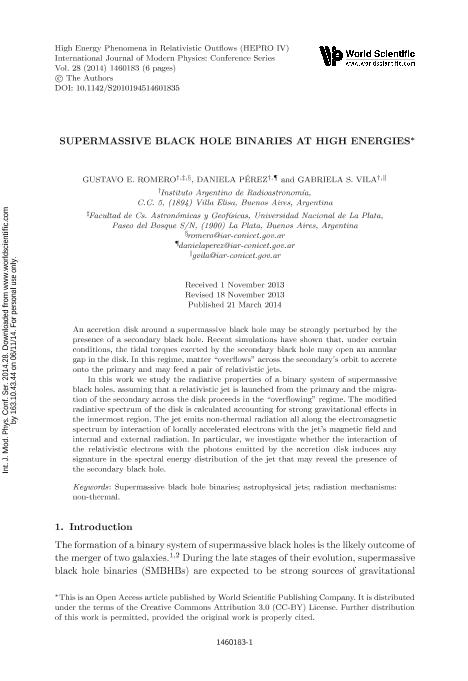Mostrar el registro sencillo del ítem
dc.contributor.author
Romero, Gustavo Esteban

dc.contributor.author
Pérez, Daniela

dc.contributor.author
Vila, Gabriela Soledad

dc.date.available
2016-03-04T20:32:19Z
dc.date.issued
2014-03
dc.identifier.citation
Romero, Gustavo Esteban; Pérez, Daniela; Vila, Gabriela Soledad; Supermassive black hole binaries at high energies; World Scientific; International Journal of Modern Physics: Conference Series; 28; 3-2014; 1460183-1460183
dc.identifier.issn
2010-1945
dc.identifier.uri
http://hdl.handle.net/11336/4641
dc.description.abstract
An accretion disk around a supermassive black hole may be strongly perturbed by the presence of a secondary black hole. Recent simulations have shown that, under certain conditions, the tidal torques exerted by the secondary black hole may open an annular gap in the disk. In this regime, matter "overflows" across the secondary's orbit to accrete onto the primary and may feed a pair of relativistic jets.
In this work we study the radiative properties of a binary system of supermassive black holes, assuming that a relativistic jet is launched from the primary and the migration of the secondary across the disk proceeds in the "overflowing" regime. The modified radiative spectrum of the disk is calculated accounting for strong gravitational effects in the innermost region. The jet emits non-thermal radiation all along the electromagnetic spectrum by interaction of locally accelerated electrons with the jet's magnetic field and internal and external radiation. In particular, we investigate whether the interaction of the relativistic electrons with the photons emitted by the accretion disk induces any signature in the spectral energy distribution of the jet that may reveal the presence of the secondary black hole.
dc.format
application/pdf
dc.language.iso
eng
dc.publisher
World Scientific

dc.rights
info:eu-repo/semantics/openAccess
dc.rights.uri
https://creativecommons.org/licenses/by-nc-sa/2.5/ar/
dc.subject
Astrophysical Jets
dc.subject
Radiation Mechanisms
dc.subject
Non-Thermal Mechanisms
dc.subject
Supermassive Black Hole Binaries
dc.subject.classification
Astronomía

dc.subject.classification
Ciencias Físicas

dc.subject.classification
CIENCIAS NATURALES Y EXACTAS

dc.title
Supermassive black hole binaries at high energies
dc.type
info:eu-repo/semantics/article
dc.type
info:ar-repo/semantics/artículo
dc.type
info:eu-repo/semantics/publishedVersion
dc.date.updated
2016-03-30 10:35:44.97925-03
dc.journal.volume
28
dc.journal.pagination
1460183-1460183
dc.journal.pais
Singapur

dc.journal.ciudad
Toh Tuck
dc.conicet.avisoEditorial
This is an Open Access article published by World Scientific Publishing Company. It is distributed
under the terms of the Creative Commons Attribution 3.0 (CC-BY) License. Further distribution
of this work is permitted, provided the original work is properly cited.
dc.description.fil
Fil: Romero, Gustavo Esteban. Consejo Nacional de Investigaciones Científicas y Técnicas. Centro Científico Tecnológico la Plata. Instituto Argentino de Radioastronomia (i); Argentina
dc.description.fil
Fil: Pérez, Daniela. Consejo Nacional de Investigaciones Científicas y Técnicas. Centro Científico Tecnológico la Plata. Instituto Argentino de Radioastronomia (i); Argentina
dc.description.fil
Fil: Vila, Gabriela Soledad. Consejo Nacional de Investigaciones Científicas y Técnicas. Centro Científico Tecnológico la Plata. Instituto Argentino de Radioastronomia (i); Argentina
dc.journal.title
International Journal of Modern Physics: Conference Series
dc.relation.alternativeid
info:eu-repo/semantics/altIdentifier/doi/http://dx.doi.org/10.1142/S2010194514601835
dc.relation.alternativeid
info:eu-repo/semantics/altIdentifier/url/http://www.worldscientific.com/doi/abs/10.1142/S2010194514601835
dc.relation.alternativeid
info:eu-repo/semantics/altIdentifier/issn/2010-1945
Archivos asociados
